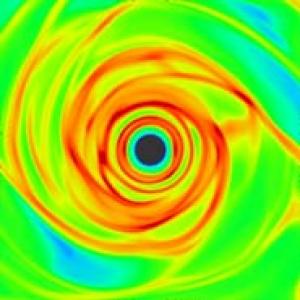February’s issue of the journal Icarus will refine an increasingly intriguing theory of planetary formation. Richard Durisen, a professor of astronomy at Indiana University – Bloomington used computer models to demonstrate the motion of gas as it condenses around a parent star. “These are the disks of gas and dust that astronomers see around most young stars, from which planets form,” Durisen said. “They’re like a giant whirlpool swirling around the star in orbit. Our own solar system formed out of such a disk.”
 What Durisen’s theory of gravitational imbalances adds to the picture is a model of how areas of stability within the planetary disks create places for denser gases to accumulate, allowing the formation of planets. That’s valuable information, because until now we haven’t understood how a gravitationally unstable disk could avoid violent interactions with other disks materials, thus destroying young planets before they could fully form.
What Durisen’s theory of gravitational imbalances adds to the picture is a model of how areas of stability within the planetary disks create places for denser gases to accumulate, allowing the formation of planets. That’s valuable information, because until now we haven’t understood how a gravitationally unstable disk could avoid violent interactions with other disks materials, thus destroying young planets before they could fully form.
Image: The rings near the center of this simulation may be protected areas where planets can start to form around a young star. Credit: Indiana University.
Durisen’s work challenges the rival ‘core accretion’ theory, which is that gas giant planets initially form, like terrestrial worlds, through solid objects colliding and growing over time. “Gas giant planets are more common than we could have guessed even 10 years ago,” Durisen said. “Nature is pretty good at making these planets.” But core accretion is challenged by the need for speed. We now know that gas disks dissipate quickly, over a few million years, so planetary formation has to be fast.
“In the core accretion theory, the formation of gas giant planets gets started by a process similar to the way planets such as Earth accumulate,” Durisen said. “Solid objects hit each other and stick together and grow in size. If a solid object grows to be about 10 times the mass of Earth, and there’s also gas around, it becomes massive enough to grab onto a lot of the gas by gravity. Once that happens, you get rapid growth of a gas giant planet.”
Observations of planets around other stars indicate that many of these gas giant extrasolar worlds could not have formed this way. They’re just too big, and because building them by core accretion could take up to 100 million years, sufficient gas resources would not remain available. That gives added credence to Durisen’s gravitational instability theory, and indicates that more than one mechanism may be at work in creating a complete solar system.
You can read more about Durisen’s work in Rings Around the Stars, an article by Hal Kibbey that explains gravitational instability theory. The upcoming article in Icarus is Durisen, Cai, Mejía et al. “A Hybrid Scenario for Gas Giant Planet Formation in Rings.”


Astrophysics, abstract
astro-ph/0703237
From: Taro Matsuo [view email]
Date: Sat, 10 Mar 2007 04:48:31 GMT (616kb)
Planetary Formation Scenarios Revistied: Core-Accretion Versus Disk Instability
Authors: T. Matsuo, H. Shibai, T. Ootsubo (Nagoya University), M. Tamura (NAOJ)
Comments: accepted for publication in The Astrophysical Journal
The core-accretion and disk instability models have so far been used to explain planetary formation. These models have different conditions, such as planet mass, disk mass, and metallicity for formation of gas giants. The core-accretion model has a metallicity condition ([Fe/H] > −1.17 in the case of G-type stars), and the mass of planets formed is less than 6 times that of the Jupiter mass MJ. On the other hand, the disk instability model does not have the metallicity condition, but requires the disk to be 15 times more massive compared to the minimum mass solar nebulae model. The mass of planets formed is more than 2MJ. These results are compared to the 161 detected planets for each spectral type of the central stars. The results show that 90% of the detected planets are consistent with the core-accretion model regardless of the spectral type. The remaining 10% are not in the region explained by the core-accretion model, but are explained by the disk instability model. We derived the metallicity dependence of the formation probability of gas giants for the core-accretion model. Comparing the result with the observed fraction having gas giants, they are found to be consistent. On the other hand, the observation cannot be explained by the disk instability model, because the condition for gas giant formation is independent of the metallicity. Consequently, most of planets detected so far are thought to have been formed by the core-accretion process, and the rest by the disk instability process.
http://arxiv.org/abs/astro-ph/0703237